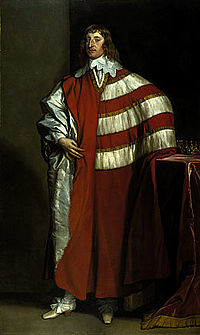Charles Seton, 2nd Earl of Dunfermline
- Charles Seton, 2nd Earl of Dunfermline
-
Charles Seton, 2nd Earl of Dunfermline PC (November 1615 – 11 May 1672), styled Lord Fyvie until 1622, was a Scottish peer.
Seton the son of Alexander Seton, 1st Earl of Dunfermline and Margaret, daughter of James Hay, 7th Lord Hay of Yester and Lady Margaret Kerr.[1] Charles was a Royalist during the Civil War, and was forced to flee the country when Charles I was executed in 1649, only to return with Charles II the next year. He held the post of Keeper of the Privy Seal of Scotland from 1661 to his death in 1672.
Lord Dunfermline was married to Mary Douglas, daughter of William Douglas, 7th Earl of Morton and Anne Keith, daughter of George Keith, 5th Earl Marischal. At his death in 1672, his two sons, Alexander Seton, 3rd Earl of Dunfermline (1642–1677) and James Seton, 4th Earl of Dunfermline (died 1694) succeeded him in turn. Both died without issue, and the title became extinct when James was outlawed in 1690.[1]
References
| Persondata |
| Name |
Dunfermline, Charles Seton, 2nd Earl Of |
| Alternative names |
|
| Short description |
|
| Date of birth |
|
| Place of birth |
|
| Date of death |
|
| Place of death |
|
Categories: - 1615 births
- 1672 deaths
- Earls in the Peerage of Scotland
- Lords High Commissioner to the General Assembly of the Church of Scotland
- Cavaliers
- 17th-century Scottish people
- Members of the Privy Council of Scotland
Wikimedia Foundation.
2010.
Look at other dictionaries:
James Seton, 4th Earl of Dunfermline — (d. December 26, 1694) was the second son of Charles Seton, 2nd Earl of Dunfermline, and succeeded to the title at the death of his brother, Alexander Seton, 3rd Earl of Dunfermline, at some point in 1677.Like his father, James was a Jacobite,… … Wikipedia
Alexander Seton, 3rd Earl of Dunfermline — Of Alexander Seton, 3rd Earl of Dunfermline (June 12, 1642 d. btw. August 23 October 27, 1677), very little is known. He succeeded his father, Charles Seton, 2nd Earl of Dunfermline, in 1672. He had no children, and upon his death in 1677 the… … Wikipedia
Earl of Dunfermline — The title Earl of Dunfermline was created in the Peerage of Scotland in 1605 for the 1st Lord Fyvie, fourth son of the 5th Lord Seton, who had been created Lord Fyvie, also in the Peerage of Scotland, in 1598. The titles were forfeit in 1690 by… … Wikipedia
Lord High Commissioner to the General Assembly of the Church of Scotland — The Lord High Commissioner to the General Assembly of the Church of Scotland is the British Sovereign s personal representative to the General Assembly of the Church of Scotland (the Kirk), reflecting the Church s role as the national church of… … Wikipedia
Lord High Commissioner to the General Assembly of the Church of Scotland — Der Royal Standard von Schottland ist auch das Banner des Hohen Kommissar der Generalversammlung der Church of Scotland Der Hohe Kommissar der Generalversammlung der Church of Scotland ist der persönliche Vertreter des Britischen Monarchen bei… … Deutsch Wikipedia
Keeper of the Privy Seal of Scotland — The office of Keeper of the Privy Seal of Scotland, one of the Great Officers of State, first appears in the reign of David II. After the Act of Union 1707 its holder was normally a peer, like the Keeper of the Great Seal. The office has remained … Wikipedia
1672 in England — Events from the year 1672 in the Kingdom of England.Incumbents*Monarch Charles II of EnglandEvents* 2 January Cash payments by the Exchequer suspended for a year, due to fears of imminent bankruptcy.cite book |last=Palmer |first=Alan Veronica… … Wikipedia
1672 — Year 1672 (MDCLXXII) was a leap year starting on Friday (link will display the full calendar) of the Gregorian calendar (or a leap year starting on Monday of the 10 day slower Julian calendar). Events of 1672 January June * March The Synod of… … Wikipedia
May 11 — << May 2011 >> Su Mo Tu We Th Fr Sa 1 2 3 4 5 … Wikipedia
Jacobite Peerage — After the deposition by the English parliament in February 1689 of King James II and VII from the thrones of England and Ireland (the Scottish Estates followed suit on 11 April 1689), he and his successors continued to create peers and baronets,… … Wikipedia

